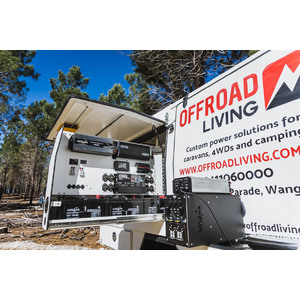So I’ve spent the last week (or three) researching me new 12v set up for 18.57-2(2010). We are heading (wife and 2 kids) off for 7 month and will be aiming for mostly off grid camping. Looking for any thoughts or suggestions before I start spending some money! This is what I am thinking:
- separated 6b&s with ignition isolators for the dmax with separate Anderson plugs. One for the fridge (red) and the other for Dcdc charger
- convert existing 8b&s cable for the fridge tlin van (from current 12 pin to red Anderson)
- run new 6b&s in van to new 20A dcdc charger. Was thinking of bigger but have done some reading and the dmax has a 90 amp alternator which I don’t want to overload.
- add another 400w solar to the roof, with new 8b&s to new 40 amp mppt solar charger. Also remove old solar converter and redirect existing 160 w panels to new mppt.
- add a direct cable with Anderson to battery for outside 200w portable blanket panel for times when I am in the shade
- new 2 x 100ah lithium battery
- disconnect from power and add new low amp 240v charger if occasional top up needed if we have power
- 2000w inverter
Any thoughts or tips very much appreciated. As always, trying to keep the cost down to a minimum. So I will be installing myself, I want to know what is where so I can do any fixes and additions while on the road. I am thinking of renology kit, looks ok and price is decent. Only thought was to put a combined 50amp dcdc solar converter combo in, but i can’t see a way to limit the amperage draw from the alternative. 50 amps for dcdc, 15 or so for the fridge, plus losses, from a 90amp alternator doesn’t seem like much left over!?
- separated 6b&s with ignition isolators for the dmax with separate Anderson plugs. One for the fridge (red) and the other for Dcdc charger
- convert existing 8b&s cable for the fridge tlin van (from current 12 pin to red Anderson)
- run new 6b&s in van to new 20A dcdc charger. Was thinking of bigger but have done some reading and the dmax has a 90 amp alternator which I don’t want to overload.
- add another 400w solar to the roof, with new 8b&s to new 40 amp mppt solar charger. Also remove old solar converter and redirect existing 160 w panels to new mppt.
- add a direct cable with Anderson to battery for outside 200w portable blanket panel for times when I am in the shade
- new 2 x 100ah lithium battery
- disconnect from power and add new low amp 240v charger if occasional top up needed if we have power
- 2000w inverter
Any thoughts or tips very much appreciated. As always, trying to keep the cost down to a minimum. So I will be installing myself, I want to know what is where so I can do any fixes and additions while on the road. I am thinking of renology kit, looks ok and price is decent. Only thought was to put a combined 50amp dcdc solar converter combo in, but i can’t see a way to limit the amperage draw from the alternative. 50 amps for dcdc, 15 or so for the fridge, plus losses, from a 90amp alternator doesn’t seem like much left over!?




